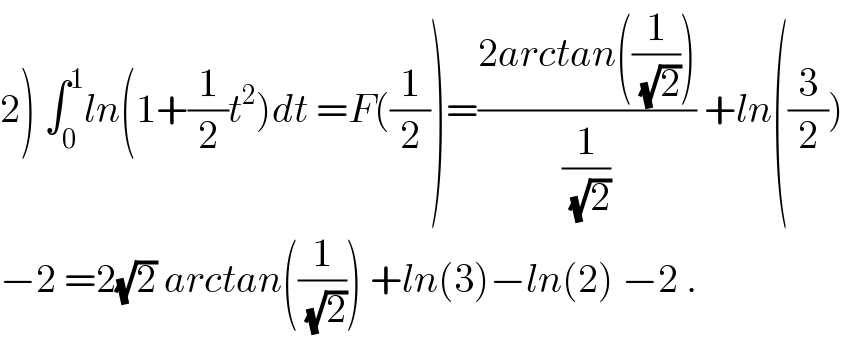
Question and Answers Forum
Question Number 38458 by maxmathsup by imad last updated on 25/Jun/18

Commented bymath khazana by abdo last updated on 28/Jun/18
![we have F^′ (x)= ∫_0 ^1 (t^2 /(1+xt^2 ))dt =(1/x) ∫_0 ^1 ((xt^2 +1 −1)/(xt^2 +1))dt =(1/x) −(1/x) ∫_0 ^1 (dt/(1+xt^2 )) so if 0<x<1changement (√x)t=u give ∫_0 ^1 (dt/(1+xt^2 )) = ∫_0 ^(√x) (1/(1+u^2 )) (du/(√x)) =(1/(√x)) arctan((√x)) ⇒ F^′ (x)= (1/x) −((arctan((√x)))/(x(√x))) ⇒ F(x) = ∫_1 ^x (dt/t) − ∫_1 ^x ((arctan((√t)))/(t(√t)))dt +c =ln(x) −∫_1 ^x ((arctan((√t)))/(t(√t)))dt +c but chang.(√t)=u give ∫_1 ^x ((arctan((√t)))/(t(√t)))dt =∫_1 ^(√x) ((arctan(u))/(u^2 .u)) 2u du =2 ∫_1 ^(√x) ((arctan(u))/u^2 ) du by parts ∫_1 ^(√x) ((arctanu)/u^2 ) du = [−(1/u) arctan(u)]_1 ^(√x) +∫_1 ^(√x) (1/(u(1+u^2 )))du = (π/4) −((arctan((√x)))/(√x)) + ∫_1 ^(√x) ( (1/u) −(u/(1+u^2 )))du =(π/4) −((arctan((√x)))/(√x)) +[ln((u/(√(1+u^2 ))))]_1 ^(√x) =(π/4) −((arctan((√x)))/(√x)) +ln(((√x)/(√(1+x)))) +ln((√2)) ⇒ F(x)= ln(x) −(π/2) +((2arctan((√x)))/(√x)) −2ln(((√x)/(√(1+x)))) −ln(2) +c F(1)=∫_0 ^1 ln(1+t^2 )dt =−(π/2) +(π/2) −2ln((1/(√2))) −ln(2) +c=c ⇒ F(x)= −(π/2) +((2 arctan((√x)))/(√x)) +ln(1+x)−ln(2) + ∫_0 ^1 ln(1+t^2 )dt by parts ∫_0 ^1 ln(1+t^2 )dt =[tln(1+t^2 )]_0 ^1 −∫_0 ^1 ((t 2t)/(1+t^2 ))dt =ln(2) −2 ∫_0 ^1 ((1+t^2 −1)/(1+t^2 ))dt =ln(2) −2 +2 ∫_0 ^1 (dt/(1+t^2 )) =ln(2) −2 +(π/2) ⇒ F(x)= ((2 arctan((√x)))/(√x)) +ln(1+x) −2 with 0<x<1](Q38660.png)
Commented bymath khazana by abdo last updated on 28/Jun/18
![if −1<x<0 we have F^′ (x)=(1/x) −(1/x) ∫_0 ^1 (dt/(1+xt^2 )) ∫_0 ^1 (dt/(1+xt^2 )) =∫_0 ^1 (dt/(1−(−x)t^2 )) =_((√(−x))t=u) ∫_0 ^(√(−x)) (1/(1−u^2 )) (du/(√(−x))) =(1/(√(−x))) ∫_0 ^(√(−x)) (du/(1−u^2 )) =(1/(2(√(−x)))) ∫_0 ^(√(−x)) ( (1/(1+u)) +(1/(1−u)))du = (1/(2(√(−x)))) [ln(((1+u)/(1−u)))]_0 ^(√(−x)) = (1/(2(√(−x)))) ln(((1+(√(−x)))/(1−(√(−x)))))⇒ F^′ (x) = (1/x) −(1/(2x(√(−x))))ln(((1+(√(−x)))/(1−(√(−x))))) ⇒ F(x)= ln(−x) − ∫_1 ^x (1/(2t(√(−t)))) ln(((1+(√(−t)))/(1−(√(−t)))))dt +c ...be continued...](Q38664.png)
Commented bymath khazana by abdo last updated on 28/Jun/18

